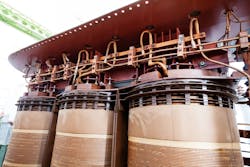Transformer Resiliency to Forge Clean Energy Future
Rising energy costs, the transition to renewable energy, extreme weather events, national security concerns and more have created a renewed focus on critical power grid technologies and overall grid reliability. The White House’s recent executive action invoking the Defense Production Act (DPA) to boost domestic manufacturing is one of the latest responses to the need to harden the nation’s grid in preparation for the future.
The invocation — which authorizes the Department of Energy (DOE) to accelerate production of transformers and other electric grid components, such as solar panels, heat pumps, insulation and electrolyzers, fuel cells and platinum metals — ultimately aims to address demand for clean energy and bolster domestic energy overall as new threats arise.
According to government data, power outages in the U.S. have increased by 50% over the last 20 years. In 2020 alone, power outages rose by 73% because of extreme weather, and the frequency and length of these outages are on the rise, as well. The U.S. Energy Information Administration (EIA) reported, on average, customers experienced just over eight hours of power interruptions in 2020, the most since the EIA began collecting electricity reliability data in 2013. In 2018, the DOE estimated outages cost the U.S. economy US$150 billion a year — and that number is likely to have increased.
With rising temperatures, severe weather events and global demand for clean energy, the need for essential products and components for sustainable and more dependable power grid infrastructure is necessary. However, the quality and condition of critical power assets cannot be overlooked. Adapting and modernizing today’s grid infrastructure presents both opportunities and challenges for utility teams.
As the industry continues to evolve and manufacture new technologies, it is essential to ensure the quality and capabilities of these assets — both contemporary and new — are properly evaluated and maintained.
Power Grid Manufacturing
Extending and maintaining the healthy condition of critical infrastructure such as transformers is essential to an efficient energy grid. Under ideal conditions, transformers can be expected to operate for about 40 years, but the life expectancy for industrial transformers may be only 20 years to 25 years. However, these life estimates are not arbitrary numbers and are dependent on how a utility monitors and cares for the assets.
Over their operational lifetime, transformers are exposed to electrical, thermal and chemical stresses that can degrade the insulating oils and solid insulation, lead to corrosion and oxidation, and cause conditions for incipient faults to develop, shortening the life of an asset. Inadequate design, increased loads and failing to properly maintain these assets all can lead to premature aging and, ultimately, premature replacement.
Transformer failure can take a toll both financially and environmentally as well as cause major disruption to the businesses and communities that rely on it. On average, the cost of installing new transformers has risen 5.5% annually over the last 20 years. Manufacturing new assets also creates a large carbon footprint, and disposing of the old equipment takes a toll because transformers typically are full of oil and carbon.
Additionally, when a transformer reaches the end of its life, either naturally or through failure, withdrawing and replacing one transformer with another can be a disruptive process that leads to prolonged outage periods. According to Willis Risk Solutions, the largest transformer loss on record occurred at a power plant, resulting in business interruption costs of more than $86 million. As the industry moves toward renewable energy use cases and reducing overall carbon emissions, evaluating the health of these assets will only become more vital to reduce unforeseen failure.
Durable Design And Production
While the recent executive order will increase the manufacturing and availability of transformers and other grid components, it is important to evaluate the transformer designs and specifications properly to ensure whole-life capacity. The right people must be inspecting and ensuring the transformers and assets are being designed according to appropriate IEEE and IEC standards.
Conducting formal design reviews can ensure a manufacturer is constructing an asset appropriate to the transformer’s intended application and technical specifications. Design reviews are especially important to test magnetic circuit, windings and insulation, impedance and loss, interoperability, thermal performance and short-circuit withstanding — factors to consider especially for renewable transformers and those specific to microgrids where the impact of harmonics may be severe and the number of energizations significantly higher than with traditional T&D units.
Additionally, factory acceptance testing, including core and coil inspections, pre-vapor phase inspections, pre-tanking and more, can ensure a transformer is manufactured properly. These inspections, whether performed in person or virtually, can prevent additional time spent ensuring the asset is running the way it should as well as prevent damage, inefficiencies and premature failure down the road.
As the nation prepares to ramp up critical infrastructure production, it is vital the industry maintains its standards for quality rather than solely focusing on quantity.
Extending Transformer Life
Provided operators take the right steps, aging transformers can operate safely and effectively well beyond their design life. While no approach will extend the life of an asset forever, proactive maintenance and advanced diagnostics can spot early signs of failure and prolong the life of an asset.
General use monitoring, including dissolved gas analysis (DGA) and temperature monitoring, is critical to evaluating the overall health of a transformer. DGA, which measures the concentration of certain key gases dissolved in the oil and rate of gas generation, provides a good general indication of the status of transformer equipment. Advanced sensors and detectors that assess transformer oil and hydrogen levels in real time can indicate and warn of abnormalities, enabling teams to catch issues before they worsen. However, DGA alone will not detect all potential problems. Continuous load and voltage tracking on-line monitoring of bushing and insulation health, partial-discharge analysis, tap-changer condition and more should be part of every utility team’s larger condition-monitoring strategy.
Making strategic decisions when it comes to condition-based maintenance of transformers requires accurate assessments. However, managing the volume of data can be overwhelming and complicated, especially with no contextual metadata. Having the appropriate solutions to navigate and provide insights on the data from DGA, oil-quality and paper-degradation analysis, insulating liquids, stray gassing, corrosive sulfur, paper/cellulose degradation and more in one place enables teams to interpret whether the risk of failure is increasing and what proactive interventions are necessary.
Operational data on an asset, including how much power is running through the equipment and at what voltage, also can provide teams with valuable information needed to make confident and informed decisions. Data on voltage use is especially important to keep track of renewable energy transformers that must be capable of addressing and responding to volatile voltage stresses.
Growing Role Of Microgrids
Another key aspect at play is the growing demand for energy independence and diversified energy sources. With outages, emissions and electric power usage surging, microgrids are quickly gaining ground as a way to provide renewable energy while avoiding prolonged outages.
Microgrids, which contain the necessary elements to operate independently of the main grid, including generation, storage and demand, can act as an emergency power source and offer enhanced power security. They are made up of a diverse mix of distributed generation — such as wind turbines, solar panels, fuel cells and biomass fuels — all of which can supply power around the clock if supported by battery storage. Microgrids also exchange energy with the main grid, offering load and generation flexibility and providing customers with the lowest cost of energy.
Microgrid adoption is growing, especially in areas that require enhanced power reliability, such as U.S. miliary bases. However, interoperability among the grid functionalities and transformers is necessary to maintain the grid’s power quality, reliability and resilience for advanced microgrid development. Microgrid generators must be regulated for the right voltage yet also must be able to interoperate with the grid itself when available or occasionally integrate with other microgrids at the same frequency and voltage. This means extending the capability of the microgrid to higher voltages and adding more transformers when necessary.
Other considerations should be kept in mind when operating transformers within microgrids, particularly as it relates to renewable energy. Microgrids generate harmonics that can distort currents in the grid and create higher voltage levels and temperatures within transformers. In wind farm grids especially, ferroresonance — which is harmonic resonance involving magnetizing reactance of the transformer and cable capacitance — also can spike voltage levels. Especially for older transformers not designed for these applications, tracking deterioration and maintenance is necessary.
Adhering to standards such as IEEE 2030.9-2019 and IEC TS 62898-1:2017, applying appropriate filtering, and taking proper considerations into account during system design and plant operation can help to prevent avoidable asset damage and consequent failures.
The Grid Into The Future
Investing in clean-energy-technology manufacturing is a significant step in the right direction to tackling climate change, bolstering energy independence and preparing for the future. However, intentional design and inspections as well as comprehensive and proactive condition monitoring are key to streamlining costs, minimizing disruption and sustaining the efficiency of transformer fleets.
Safeguarding the reliability of these large capital items is a result of careful technical processes and considerations as part of a larger strategy to get the most out of these assets. Ensuring the optimal health and performance of transformers and new critical infrastructure is a necessary action to forge a cleaner energy future.
Tony McGrail is solutions director for asset management and monitoring technology at Doble Engineering Co., providing condition, criticality and risk analysis for utilities. Previously, he spent over 10 years with National Grid in the UK and the U.S., as both a substation equipment specialist and an asset policy manager, identifying risks and opportunities for investment in an aging infrastructure. McGrail is chair of the IEEE working group on asset management, a member of IET, CIGRE and IAM, as well as a contributor to SFRA and other standards at IEEE, IEC and CIGRE. His initial degree was in physics, supplemented by a master’s degree and a doctorate in electrical engineering as well as an MBA degree. McGrail is an adjunct professor at Worcester Polytechnic Institute, Massachusetts, leading courses in power systems analysis.
About the Author
Tony McGrail
Tony McGrail is solutions director for asset management and monitoring technology at Doble Engineering Co., providing condition, criticality and risk analysis for utilities. Previously, he spent over 10 years with National Grid in the UK and the U.S., as both a substation equipment specialist and an asset policy manager, identifying risks and opportunities for investment in an aging infrastructure. McGrail is chair of the IEEE working group on asset management, a member of IET, CIGRE and IAM, as well as a contributor to SFRA and other standards at IEEE, IEC and CIGRE. His initial degree was in physics, supplemented by a master’s degree and a doctorate in electrical engineering as well as an MBA degree. McGrail is an adjunct professor at Worcester Polytechnic Institute, Massachusetts, leading courses in power systems analysis.



